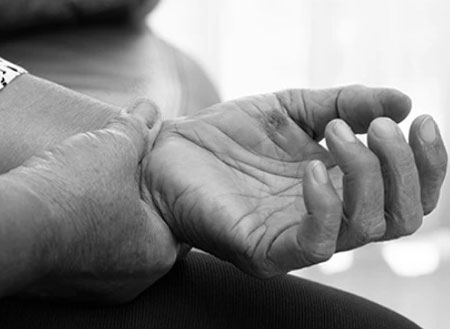
Nerves can be the blessing and curse of the human body. They innervate muscles and allow us to feel and function, but if hindered, they can wreak havoc. Two of the most common nerve pathologies in orthopedics are carpal and the far less common cubital tunnel syndrome.
Let’s start with carpal tunnel syndrome. The carpal tunnel is an area in the wrist through which the median nerve and 9 tendons make their way from the forearm into the hand. This tunnel can develop inflammation and swelling (acutely, or more often chronically), which can pinch the nerve and prevent it from firing appropriately. When this happens, patients experience pain, numbness, tingling, lack of dexterity, and/or loss of grip strength. These symptoms occur primarily in the thumb, index, middle, and ring fingers and are often worse at night.
Cubital tunnel syndrome, on the other hand (pun intended), occurs when the ulnar nerve is pinched or stretched where it runs through the groove on the inside of the elbow. Contrary to popular belief, hitting the ‘funny bone’ is not actually funny. In all reality, it is remarkably uncomfortable because the ulnar nerve resides superficially and is easily affected by trauma, such as accidentally knocking your elbow on the kitchen counter; thus, causing a shooting sensation into your hand. Otherwise, symptoms of cubital tunnel syndrome are similar to those of carpal tunnel except they occur in the ring and small fingers. Such symptoms can be exacerbated when the elbow is bent, causing the nerve to be stretched and irritated.
The diagnosis of carpal or cubital tunnel syndrome is made based on reported symptoms and medical history, as well as nerve conduction testing such as an electromyogram (EMG) or monofilament test. A monofilament test is administered during your office visit to quickly assess sensation whereas an EMG is a more-involved procedure that measures the electrical activity of the nerve in question using electrodes applied to the skin. We have two physicians who perform EMGs to aid our hand specialists in determining the extent of a nerve pathology. Sometimes in determining whether symptoms are related to a nerve pathology or arthritis, a cortisone injection is used for both diagnostic and therapeutic purposes. If symptoms resolve with a steroid
injection administered in the carpal tunnel, the symptoms can likely be attributed to carpal tunnel.
Treatment can be both noninvasive and surgical. Initial treatment often includes the aforementioned cortisone injection to reduce inflammation affecting the nerve and a night splint to keep the wrist in a neutral position. Plenty of patients feel relief of their symptoms with these conservative measures and do well for months on end before their symptoms are bothersome again. Educating patients as to what daily activities likely aggravate their symptoms and finding strategies to avoid them can be helpful as well. Ultimately, the solution is a carpal tunnel or cubital tunnel release performed under local anesthesia at The Orthopaedic Surgery Center. These are minimally invasive procedures to relieve the pressure on the nerve. A carpal tunnel release entails snipping the ligament that forms the top of the tunnel to allow more room for the nerve. A cubital tunnel surgery involves a nerve transposition so the nerve is less easily aggravated. Both procedures have a quick recovery and resolution of symptoms so patients can get back to normal.
This blog is written by one of our very own-Morgan. She is a certified athletic trainer working as a medical assistant with our providers each and every day in our clinic. She obtained a bachelor's degree in athletic training from Carroll University in Waukesha and a master's degree in Kinesiology from Michigan State University. She is excited to bring you updates and information about the happenings at OAW.

